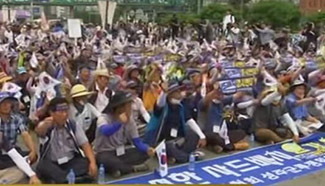SAN FRANCISCO, Feb. 28 (Xinhua) -- A researcher at the University of California, Berkeley, has developed a wearable sweat sensor network that can measure rapid fluctuations in electrolytes and metabolites, and the buildup of heavy metal concentrations in perspiration.
By combining innovative materials, sensor technology and integrated circuits, Ali Javey, a materials scientist and professor of electrical engineering and computer sciences, built, actually printed, prototype sweat sensors on thin plastics and embedded them in headbands or wristbands, so as to monitor concentration levels of metabolic markers in real-time.
The sensors are chemically coated electrodes that measure voltage or current as a proxy for electrolyte concentration. Electrodes differ based on the type of chemical they are designed to detect. The integrated circuit portion of the wearable device converts the measured voltage and current to a readout of a given chemical concentration. Since signal output is temperature-sensitive, the chip is needed to continuously calibrate the sensors to assure they accurately record concentration as the sweat temperature changes.
In Javey's lab, the lightweight sensor network tracks half a dozen chemical markers in sweat as volunteers toil on a bike. As they huff and puff, volunteers can monitor spikes or dips in their electrolytes, metabolites and skin temperature on a smart phone or other mobile device via Bluetooth. The readouts can be transmitted wirelessly to other sites for more detailed analysis.
While the current project can simultaneously monitor changes in sodium, potassium, calcium, glucose, lactate, and heavy metal levels, among others, Javey is refining the sensor fabrication process to make it more commercially practical for fitness training, athletics, health diagnostics and even large-scale population studies. He is collaborating with exercise physiologists and medical researchers to determine how reliably the changes measured by the sensors "map" with workout intensity and certain measures of health status.
"About half of the California adult population is pre-diabetic," Javey was quoted as saying in a news release from UC Berkeley on Tuesday about his project. "It is an alarming condition that leads to diabetes if your eating and living habits don't change. But most people don't know they have the condition. And many of us hate going to the doctor - and hate blood draws to determine blood glucose levels."
Preliminary research suggests that sweat may be a reliable reservoir to draw on for moment-to-moment glucose measures, Javey said. Sweat sensors could provide the first non-invasive and inexpensive home test. In addition, the sensors could potentially be used to detect the onset of fatigue and dehydration in athletes during prolonged exercise activities.












